|
Explorations
in Southern Ethiopia
By
the late Eunice
Rawlings
 It
was May 12th, 2000. The 26th Annual Congress had been a good
one, and even after a late final soiree, 15 ATA members from
Southern California assembled eagerly in the Hilton lobby to
begin our tour of Ethiopia's famous Historic Route, Axum,
Lalibela, Bahar Dar and Gondar. Once at Bole International
Airport in Addis Ababa, airport we passed through
formalities and waited in the departure lounge. After we had
bought everything possible in the gift shop, time began to
drag and we became aware of solemn faces all around us.
Finally, an Ethiopian Airlines representative informed us
that Ethiopia and Eretria were officially at war and going
north was not an option. It
was May 12th, 2000. The 26th Annual Congress had been a good
one, and even after a late final soiree, 15 ATA members from
Southern California assembled eagerly in the Hilton lobby to
begin our tour of Ethiopia's famous Historic Route, Axum,
Lalibela, Bahar Dar and Gondar. Once at Bole International
Airport in Addis Ababa, airport we passed through
formalities and waited in the departure lounge. After we had
bought everything possible in the gift shop, time began to
drag and we became aware of solemn faces all around us.
Finally, an Ethiopian Airlines representative informed us
that Ethiopia and Eretria were officially at war and going
north was not an option.
We didn't
think going back to the hotel for several days was an option
either. Our wonderful tour director George from
Tourman's/Ethiopia Tours gave us some ideas for alternative
arrangements and a phone call to Commissioner Sukkar enabled
us to negotiate with the airport operations manger, Bekele
Kidane who graciously found just the right sized Ethiopian
Airlines plane for us.
 We
invited members of other groups that were stranded and
picked up a couple of hitch-hikers from other galaxies and
19 of us including the steward boarded a sturdy twin-engine
prop plane and headed to Arba Minch, 505 kilometers
southwest of Addis. To Ethiopian Airline's credit this whole
operation was concluded by about 11:30 am. As we headed
south and munched on boxed lunches, we passed over
spectacular scenery. After leaving the modern skyline of
Addis Ababa we found ourselves marveling at a giant
patchwork of little farms with fields of green, gold and
brown, each with its cluster of round, thatched homes. We
invited members of other groups that were stranded and
picked up a couple of hitch-hikers from other galaxies and
19 of us including the steward boarded a sturdy twin-engine
prop plane and headed to Arba Minch, 505 kilometers
southwest of Addis. To Ethiopian Airline's credit this whole
operation was concluded by about 11:30 am. As we headed
south and munched on boxed lunches, we passed over
spectacular scenery. After leaving the modern skyline of
Addis Ababa we found ourselves marveling at a giant
patchwork of little farms with fields of green, gold and
brown, each with its cluster of round, thatched homes.
Arba Minch,
the Lakes and Nech Sar National Park
We passed over lakes and steep craggy cliffs. As we came
closer to our destination, Arba Minch, the scenery turned to
brilliant green and Chamo and Abaya, the largest of the Rift
Valley lakes, shimmered back at us. Arba Minch airport
consisted of a tin roof shed with bathrooms in a nearby
field. Next door to these amenities a modern, unfinished
airport structure rose as a phoenix from the ashes, possibly
waiting for the war to be over, so that more funds would be
available to complete it. Curious, friendly people who
enjoyed posing for pictures and kept us entertained until
our vehicles arrived surrounded us. The minivans had seen
better days, but given the circumstances they and their
owners did very well by us. Our pilots bid us farewell and
promised to come back for us in a couple of days.
After a
short ride we arrived at our destination, the Bekele Molla
Hotel. The main building was whitewashed and dripping with
bouganvillias, the terrace had a view that was
indescribable. We had several weather changes during our
brief stay which only intensified the superb vista of lakes
Chamo and Abaya, the intense greens of Nech Sar National
Park, the magnificent mountains and the inimitable African
skies filled with giant, soaring birds.
The
accommodation was in twin bungalows. Very basic. The
bathrooms were spartan and as we learned later, water was
iffy. Some rooms had water for a while; some showers shut
off just as one had worked up a good lather and some had no
water. The windows were ill fitting so the mosquitoes
declared May 12 ñ 14 a new feast day. Never have I
been so glad to be with such a wonderful group of people. We
all laughed at each otherís tales of woe, which we
shared over breakfast.
Meals at
the hotel were also an adventure. But when you consider that
18 of us descended on them on a moment's notice, the chef
did a great job. The menu didn't change much, fish, beef,
spaghetti and soup. We all soon learned that the fish was
incredible (freshly caught from the lake) and the servings
were huge. On our final evening, we were presented with
breaded Tilapia served on special stands so that it looked
as though the fish were swimming along the table. The flesh
was easily removed with a fork from each side of the fish
and it was truly out of this world.
 Green
Crocodiles and Pink Flamingos Green
Crocodiles and Pink Flamingos
We were unable to visit some of the different communities
and main attractions in the area because most roads had been
washed out. We did take a wild boat ride across lake Chamo
to see the basking grounds of hundreds of Nile crocodile,
(some reach 30 feet in length), with hippos, pink flamingos
and storks close by. Our return was quite late in the
afternoon and a storm was brewing. The gathering clouds and
the setting sun made a memorable panorama of changing light
dancing on the water and bouncing off the mountains. That
night the heavens opened and it poured!
Shopper's
Paradise
The rain continued until after lunch the next day. Near our
hotel was a small 'gift shop' which was full well priced
local treasures. We bought wonderful pots, jewelry, lip
plates and other reminders of the area. We heard later that
our little shopping spree had provided enough revenue to
feed the storeowner's family for six months. We went into
town and walked around the market, a collection of little
canvas covered, ground level stalls, which on this day were
little islands of dark brown mud surrounded by water. Some
of us purchased beautiful shammas the finely hand-woven
cotton shawls worn by most Ethiopians. We concluded the
day's activities by dropping in, uninvited, on a small
village in the country. We were welcomed by young and old
alike and were made to feel very much at home.
Awash and
Awash National Park
We flew back to Addis and boarded a waiting tour bus that
took us southeast to Awash. Arriving late in the evening, we
stayed at a hotel that was in a walled enclosure with rooms
around the perimeter. There was a large open area in the
middle with an assortment of small livestock. Dinner was
delicious. There was no water to drink. We had to make do
with beer or Coca-Cola. Aside from a dead bat in one of the
rooms, (just a tiny one) the accommodation was clean and
comfortable. It was hot though, and all of us had packed to
go north, so in the rooms with no air-conditioning; well,
you get the idea. We awoke to find that we had were staying
at the Hotel Paradise
Our morning
saw us exploring Awash National Park where dik dik,
waterbuck, ostrich, gazelle, zebra, oryx and other plains
game as well as cats may be seen. Our game viewing was not
good, but a large group in a large bus preempts any serious
sightings.
Meeting the
Nomads of Southern Ethiopia
Truly exceptional, was an encounter with the nomadic peoples
of the area who appeared by the Awash river where we had
stopped at a clearing to stretch our legs and admire and
photograph some exquisite purple rollers, one of Ethiopia's
830 species of birds. They came in a long, dignified
procession, slowly and quietly, the men dressed in little
more than a toga, with huge machete like knives at the
waist, and the women, shy yet beautiful, some wearing
colors, others in traditional off-whites. With them came a
large group of haughty camels, long horned cattle, goats and
donkeys. The scene was magic, as the various animals came to
the water's edge to quench their thirst.
These good
folk weren't particularly thrilled to see us and didn't want
their pictures taken. When offered Birr (Ethiopian
currency), in return for a pose they scoffed at us. "What
will we do with money"? They queried. It didn't help that
the chief decided that George was looking at his women, and
started chasing us brandishing an ancient shotgun. We
swiftly boarded the bus and headed towards Addis.
Another
similar incident occurred when we stopped to get a close-up
look at some great water birds. We drove over a marshy area
then walked the final few yards. From a distance we could
see a large herd of camel and pretty soon two fierce young
men with a halos of hair, and big machetes came and asked
why we were observing their camels. When George tried to
explain that we were looking at birds, they clearly thought
it was a pretty lame excuse. "Birds! Who looks at birds"?
Again, we excused ourselves and continued to
Addis!
This wasn't
the journey we planned and we didn't accomplish a whole lot,
but we wouldn't have missed this excursion for anything. For
one thing, it was a great bonding experience for the group.
But more than that, it was a humbling, learning experience.
Ethiopia is two and a half times the size of France, so it
is possible to be in a country at war and not be in danger
and it is equally possible to be in southern Ethiopia and
not see a sign of drought. Ethiopia is a land of many
contrasts and as travel professionals we must spread the
word that Ethiopia is a country that offers much to the
traveler and with proper preparation a visit will be a safe
and enriching experience.
Our tour
operator in Ethiopia was Tourman's Ethiopia Tours, Addis
Ababa.
Eunice
Rawlings passed away in 2001.
|
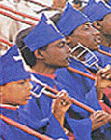

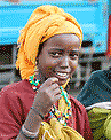
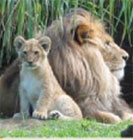
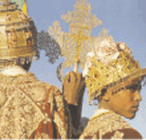
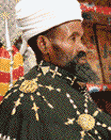
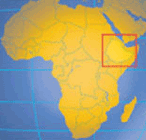
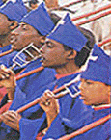
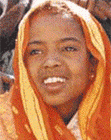

 It
was May 12th, 2000. The 26th Annual Congress had been a good
one, and even after a late final soiree, 15 ATA members from
Southern California assembled eagerly in the Hilton lobby to
begin our tour of Ethiopia's famous Historic Route, Axum,
Lalibela, Bahar Dar and Gondar. Once at Bole International
Airport in Addis Ababa, airport we passed through
formalities and waited in the departure lounge. After we had
bought everything possible in the gift shop, time began to
drag and we became aware of solemn faces all around us.
Finally, an Ethiopian Airlines representative informed us
that Ethiopia and Eretria were officially at war and going
north was not an option.
It
was May 12th, 2000. The 26th Annual Congress had been a good
one, and even after a late final soiree, 15 ATA members from
Southern California assembled eagerly in the Hilton lobby to
begin our tour of Ethiopia's famous Historic Route, Axum,
Lalibela, Bahar Dar and Gondar. Once at Bole International
Airport in Addis Ababa, airport we passed through
formalities and waited in the departure lounge. After we had
bought everything possible in the gift shop, time began to
drag and we became aware of solemn faces all around us.
Finally, an Ethiopian Airlines representative informed us
that Ethiopia and Eretria were officially at war and going
north was not an option.
 Green
Crocodiles and Pink Flamingos
Green
Crocodiles and Pink Flamingos